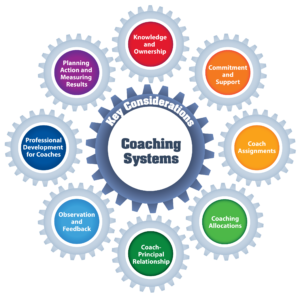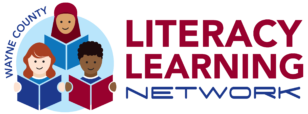Literacy Coaching
Why Coaching?
Broadly defined, coaching is a form of professional learning that takes place within classrooms that helps teachers develop and apply new knowledge, make concrete plans for instruction and assessment, obtain feedback, refine their practices, and examine results. Research shows that strong coaching can make a significant difference in teacher practice and student outcomes.
A well designed coaching model has great benefits and can incorporate an array of interrelated approaches that promote coherence, focus, and alignment at multiple levels within a school system.


When employed and supported effectively, instructional coaching enhances district professional development systems by providing schools and central office personnel with sustained, targeted supports to build knowledge, improve practice, and promote student achievement. Research on professional development suggests that it is most effective when it
- includes components that are based in school-wide initiatives,
- is embedded in teaching and learning,
- increases teachers’ theoretical understandings of their work,
- is collaborative and inquiry-based.
- Invests in human capital by building instructional and leadership capacity based on adult learning and change theory.
• Creates sustainability by supporting the systemic improvement efforts of school communities that go beyond individual teacher behavior.
• Leads to equity and accountability by providing differentiated, targeted supports and increased collective responsibility throughout a school system. - Creates coherence between school practice and district initiatives as coaches become conduits for professional learning that connects to a system-wide vision and goals.

- Promotes positive cultural change by creating conditions, behaviors, and practices that embed instructional change within broader efforts to improve school culture and climate.
- Fosters constructive and productive relationships between coaches and teachers by protecting confidentiality and ensuring that coaches have no involvement in the teacher evaluation process.
- Supports collective, interconnected leadership across a school system where large numbers of school personnel feel ownership and responsibility for leading improvement efforts in
teaching and learning.
A growing body of research suggests that coaching is a promising element of effective, district-supported professional development in the following ways:
- Effective coaching encourages collaborative, reflective practice. Most studies show that coaching leads to improvements in instructional capacity. Teachers supported by a coach, tend to
apply their learning more deeply, frequently, and consistently than teachers working alone.
• Effective coaching encourages the use of data analysis to inform practice. Instead of working in isolation, teachers can work within guided teams to target specific practices that support issues, such as closing opportunity gaps, supporting teachers across career stages, and advocating for equity. - Coaching can sustain professional learning and support implementation into practice. Coaching is an important element of a professional development system. To be most effective, coaching should be seen as an integrated part of a broader system. It must be explicitly linked to other professional learning opportunities and components of systemic improvement, such as small learning communities or district-wide frameworks. Because coaching takes place in classrooms, observation, learning, and experimentation occur in real situations with immediate feedback to promote effective implementation.
To establish a system that prioritizes ongoing, job embedded professional learning that teachers want and need, districts must commit energy and resources. According to the Annenberg Institute for School Reform, “the best way to build a coaching system is by doing it—but doing it as a collective enterprise embedded in the larger district context, rather than as an isolated project.”
To that end, there are key considerations that district leaders should thoughtfully explore as they build or strengthen their district model. Embedded within this site are interrelated considerations, along with the foundational principles and essential questions, to guide dialogue and planning by district teams.
How Coaching Supports an Equity Framework
References:
- Annenberg Institute for School Reform. (n.d.) Instructional coaching: Professional development strategies that improve instruction. Providence, RI: Brown University Annenberg Institute for School Reform. Retrieved from https://www.annenberginstitute.org/sites/default/files/product/270/files/InstructionalCoaching.pdf
- Bloom, G. (2009). Blended coaching: Skills and strategies to support principal development.
- Cheltenham, AU: Hawker Brownlow Education.
- Casey, K. (2006). Literacy coaching: The essentials. Portsmouth, NH: Heinemann.
- City, E. A., et al. (2014). Instructional rounds in education: A network approach to improving teaching and learning. Cambridge, MA: Harvard Education Press.
- Fullan, M., & Knight, J. (2011). Coaching as system leaders. Educational Leadership, 69(2). Retrieved from http://www.ascd.org.
- Hammond, Z. (2015). “Culturally Responsive Teaching & the Brain: Promoting Authentic Engagement and Rigor among Culturally and Linguistically Diverse Students.” Thousand Oaks, CA: Corwin Press.
- Killion J., Harrison C., Bryan C., & Clifton, H. (2012). Coaching matters. Oxford, OH: Learning Forward.
- Knight, J., et al. (2009). Coaching approaches and perspectives. Thousand Oaks, CA: Corwin Press.
- Knight, J. (2018). The impact cycle: What instructional coaches should do to foster powerful improvements in teaching. Thousand Oaks, CA: Corwin.
- Lindsey, D. (2007) Culturally proficient coaching: Supporting educators to create equitable schools. Thousand Oak, CA: Corwin Press
- Lindsey, R. B., Robins, K. N., & Terrell, R. D. (2003). Cultural proficiency: A manual for school leaders (2nd ed.). Thousand Oaks, Calif.: Corwin Press.
- Michigan Association of Intermediate School Administrators General Education Leadership Network Early Literacy Task Force. (2016). Essential school-wide and center-wide practices in literacy. Lansing, MI
- Singleton, G & Linton, C. (2006) Courageous conversations about race: A field guide for achieving equity in schools. Thousand Oaks, CA: Corwin Press
- The University of Florida Lastinger Center for Learning, Learning Forward, & Public Impact. (2016). Coaching for impact: Six pillars to create coaching roles that achieve their potential to improve teaching and learning. Gainesville, FL: University of Florida Lastinger Center; Oxford, OH: Learning Forward; and Chapel Hill, NC: Public Impact. Retrieved from www.learningforward.org.
- von Frank, V. (2010). Coaches root out deep bias. JSD, Vol. 31 No. 4:
Retrieved from www.learningforward.org
